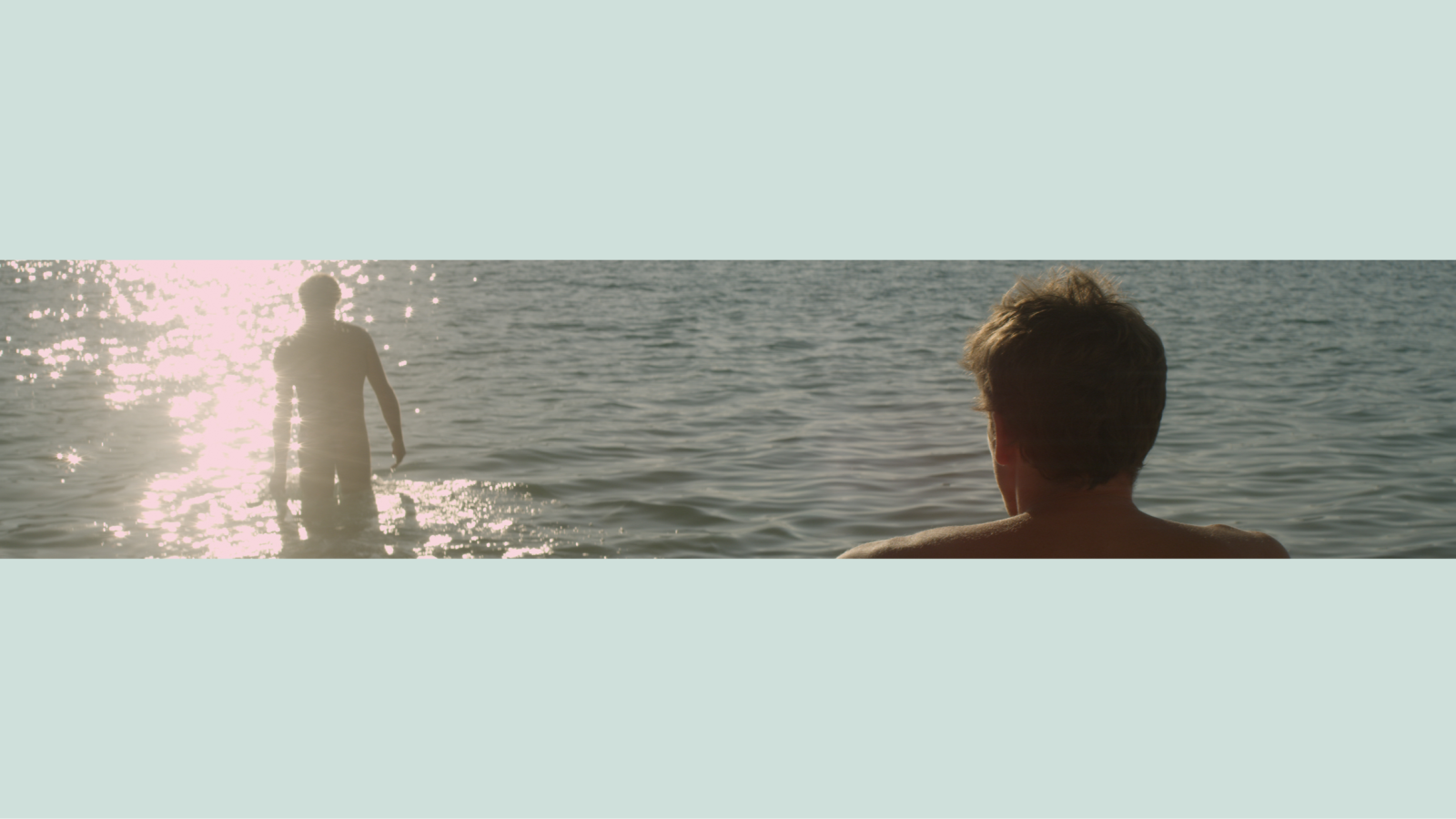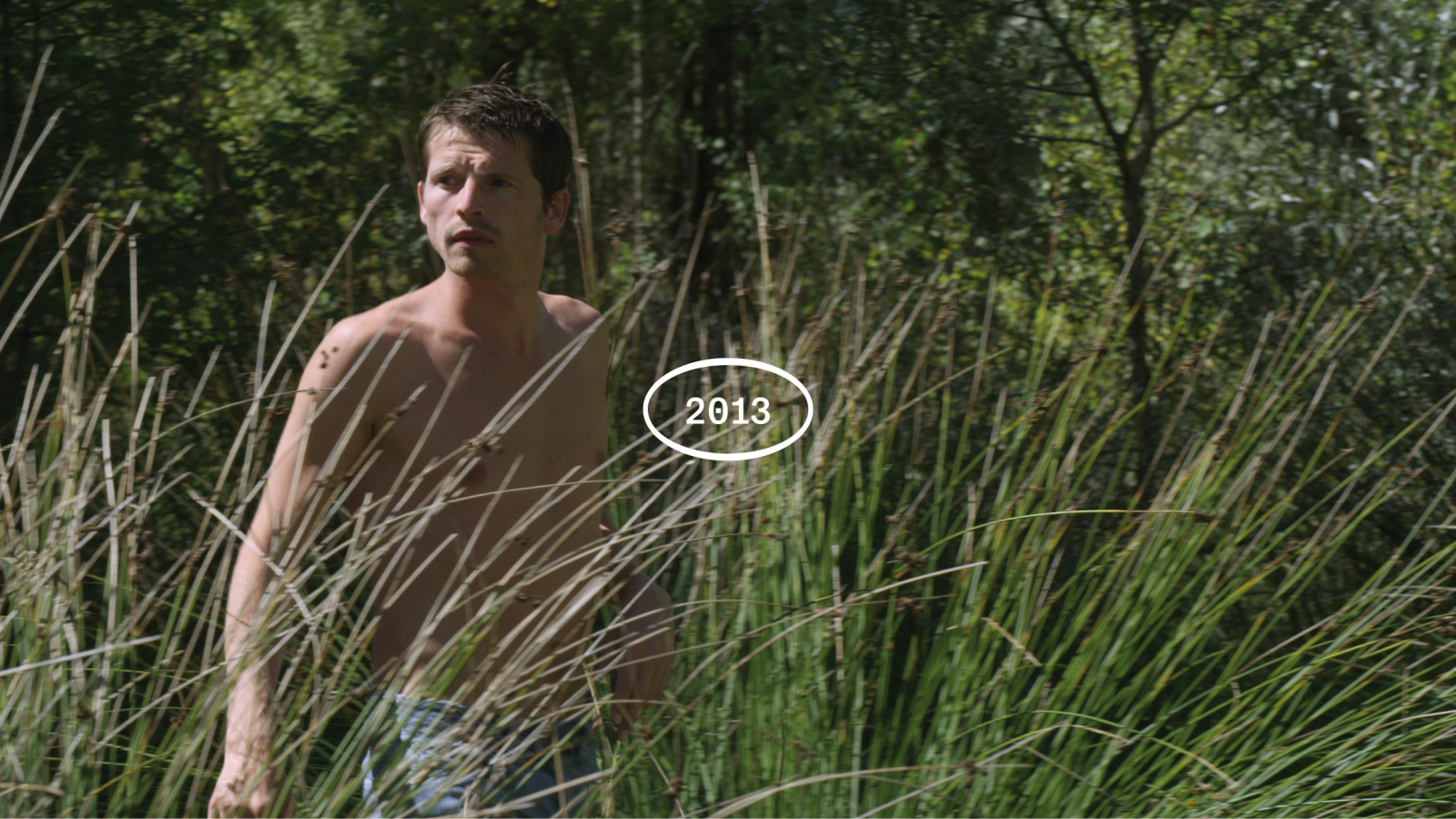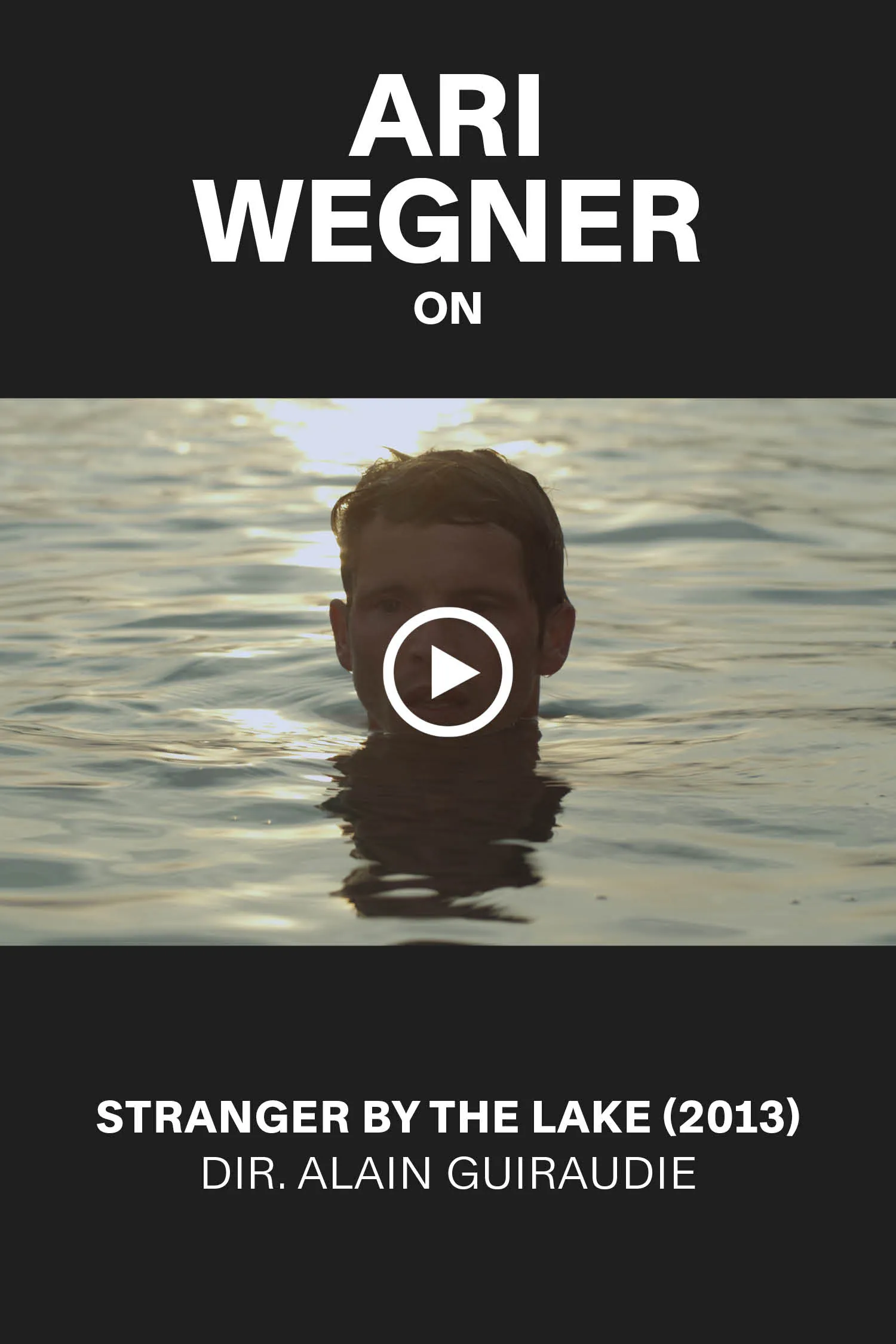Death Drive & the Gay Psyche
By Tim Murphy

Stranger by the Lake, dir. Alain Guiraudie, 2013
DEATH DRIVE
The homoerotic thriller Stranger by the Lake reflects the contemporary gay male psyche—whether we like to think so or not
By Tim Murphy
September 1, 2023
In 2014 I was writing a feature article for New York magazine about PrEP, the HIV-prevention pill that, since its FDA approval two years prior, had revolutionized gay life in New York City. Among the many benefits of the drug, it ended (or at least heavily reversed) the gay community’s 30-year and largely self-enforced policy of condom use. After three decades of gay sex’s being linked to infection, illness, death, grief and loss, gay men were—many of them for the very first time—having “Sex Without Fear,” which was actually the title of the story. I remember many things about the story—among them, the joy of younger gay men finally able to have the kind of unworried, wild sex they’d heard reigned supreme in the 1970s, and the anger of older men (especially longtime AIDS survivors) who thought that supplanting condoms with PrEP was irresponsible and disrespectful to the deceased, even though they themselves would have killed for such a pill in the 1980s and ’90s. But what I remember the most is an LGBTQ health researcher telling me about a study she did finding that a significant portion of gay men said they thought about illness and death every time they had sex.
Whoa. Talk about a tragic conflation. I thought about how unlikely it was that visions of illness and death accompanied straight people’s sexcapades, and how profoundly this statistic showed that for gay men, there was no separation between the pleasure of sex and the shadow of death, that the two were so intimately intertwined that there was no choice except for the braiding itself to become erotic. I remembered a safe-sex ad I’d seen in a 1990s gay magazine, in which a hot man is about to be penetrated by an enormous scorpion, its sharp black stinger just inches from the man’s anus, and another ad for a famous gay rave called the Black Party, in which three large snakes are crawling over a man’s muscular butt, perilously close to entering his anus. Both images had hugely turned me on when I was your typical 1990s HIV-negative-but-deathly-scared-of-AIDS gay twentysomething. If I’d already intuitively understood gayness, and gay sex, to be something bad and punishable before my 1980s adolescence, then the emergence of AIDS solidified it—if you’re condemned to gay desire, there is no acting on that desire without courting the Angel of Death. In fact, 2014 also marked the U.S. release of Stranger by the Lake, the gay French filmmaker Alain Guiraudie’s erotic psychological masterpiece, which had won him Best Director at the Cannes Film Festival’s Un Certain Regard the year before. In interviews Guiraudie, nearing 50 at the time, said that it was his attempt to follow up his more experimental cinematic works with something linear and naturalistic, that squarely depicted the gay world he knew, with its different types: handsome young ingénue, darkly seductive homme fatal, and those sidelined in this sexual arena by age and unattractiveness. He succeeded. I know few cineast gay men who don’t love this gorgeous film, which has been widely compared to the best of Hitchcock for its use of composition and photography to convey worlds of menacing unspoken meaning. It is set entirely on a pebbly stretch of beach on the side of a lake in the South of France that functions as a gay sunbathing spot, with cruising and sex going on in the adjacent enchanted woods. Several lingering long shots are almost painterly in their vivid detail. That includes the film’s very first shot, of the parking lot adjacent to the beach, which provides clues—whose cars are there, and when—that drive the plot.

Franck (Pierre Deladonchamps), the film’s protagonist, is a daily visitor to the spot. He’s largely uncharacterized, except for being young, lithe and handsome. Franck strikes up an awkward but poignant acquaintance with Henri (Patrick d’Assumçao), a fat, melancholy and solitary older man who recently lived with a girlfriend. Franck also embarks on a lakeside affair with Michel (Christophe Paou), the locale’s resident 1980s Tom Selleck heartthrob—an affair that is complicated when Franck secretly watches (via an iconic, four-minute-long shot filmed from Franck’s POV hidden in the woods) as Michel drowns another lover at dusk, when the swimming duo think they’re alone. Does this compel Franck to run as far away from Michel as he can, before he becomes the next trick turned victim? Of course not. Franck becomes more obsessed with Michel and tells no one of the murder he’s witnessed, not even after the body is found and a (presumably) straight police investigator starts stalking the shoreline, asking questions about the unusual death.
Oh, and I forgot the film’s recurring conversations between the characters about the silurus, the large, black, snakelike catfish that, according to lakeside lore, can presumably attack and kill swimmers.
Left two images: The Boys in the Band, dir. William Friedkin, 1970. Right two images: Cruising, dir. William Friedkin, 1980
You only need that much plot summary to perceive Stranger by the Lake as an allegory for the very sort of desire-equals-danger, sex-equals-death equation of the contemporary gay psyche. It's an equation that the booming popularity of PrEP in the past decade has still not completely undone, as was made clear by the summer of 2022’s brief international outbreak of sexually transmitted monkeypox, seldom fatal but often painful and disfiguring, which had gay men briefly paralyzed with the same fear about which activities were and weren’t “safe.” More to the point, it’s an equation I’m not convinced many gay men want completely undone, as for better or worse it has fueled our fantasies for so long. Stranger follows in a tradition of films that many gay men adore because they eroticize depravity and danger as much as they warn against them.
Two in particular are the classics, The Boys in the Band (1970) and Cruising (1980), both directed by William Friedkin, a straight director who had a canny eye for gay nuance and contradiction. Both were made before AIDS became known—in Cruising’s case, virtually on the eve of the epidemic’s outbreak—and yet both wrap their depictions of gay urban life in a delicious darkness. In Boys, which involves an all-night, liquor-soaked birthday gathering of eight gay friends, the darkness is largely psychic—the knowledge that there is no gay urban life without, to paraphrase one of the character’s lines toward the end, a certain measure of self-hatred. Cruising’s darkness is, like Stranger’s, more overtly homicidal: There is a serial killer stalking NYC’s gay leather and S&M venues, filmed as alluring, shadowy chambers driven by gloomy, menacing post-punk music. Straight but sensitive cop Al Pacino must leave behind the sun-filled loft where he lives with his girlfriend and descend, in a leather cap and jacket, into the city’s gay erotic underworld, full of aggro, hyperbutch man-on-man sex utterly devoid of warmth, affection or lightness.
Yes, Cruising cannily includes a sweet, boy-next-door, “normal” gay aspiring playwright, Ted (Don Scardino), as though it were covering its ass (so to speak) by saying that, no, not all gay men are drawn to darkness. But that character ends up being murdered, likely by his (of course menacingly hot) boyfriend—last seen, in one spectacularly gory shot, splayed on his bathroom floor—and his inclusion in the film did nothing to stop the outrage directed at Cruising by much of the activist gay community at the time.
“Stranger follows in a tradition of films that many gay men adore because they eroticize depravity and danger as much as they warn against them.”
That same community also condemned the to-be-gay-is-to-be-doomed message of The Boys in the Band, whose stage incarnation (written by Mart Crowley) made its off-Broadway debut in 1968 but whose film version was released in 1970, less than a year after the Stonewall riots. Already gays were saying, “Enough with the tragic depictions of us—we are a normal, happy and free people.” But much of the allure of the film version of The Boys in the Band derives from its aura of moody, drunken, pill-sodden darkness, while Cruising’s power derives almost completely from its sinister chiaroscuro.
What is it about these films, as well as their nephew, Stranger by the Lake, that has long had such a hold on us? In all three films, noirishness—the shadow of death, really—becomes an aesthetic that is more powerful than any sort of cautionary morality tale their stories may be trying to convey about the dangers of immersing oneself in a life of sex without meaning or connection. In Stranger, the camera casts a hypnotically voyeuristic eye over the satyr-like interactions set against a plein air panorama of lake and forest. Often Guiraudie shoots scenes in a sustained medium- or long-range master shot, to some extent precluding character subjectivity and interiority and instead inviting us to gawk from the outside as we would at a porn film. (The film raised critical eyebrows for its inclusion of sex scenes, shot partly with doubles, almost genitally graphic enough to qualify as porn.)

As a gay viewer, yes, I know these films are not comprehensive depictions of gay life, which can be full of love and connection, be it in the form of sexual relations or friendships (the latter of which, The Boys in the Band, must be given credit for showing with great humor and tenderness). And yet ultimately it’s the bleakness of the films, the dubious fantasy of being trapped in a purgatory of beautiful bodies and instant, anonymous sex, that I find so compelling. Their power comes from the sealed worlds they create and not from the fact that they are warning us off that world by depicting its dangers, or at least its emptiness and spiritual disappointments.
Certainly Guiraudie writes moral chastisement into Stranger by the Lake. It is the inspector, the frowning straight outsider, who punctures the idyllic gay bubble in order to judge and who, late in the film, vocalizes what many straight—and even gay—viewers may already think: “You guys have a strange way of loving each other sometimes.” But his moral imperative does not carry the day. To allow a few spoilers, he ends up abruptly stabbed to death by the menacingly hot Michel. And then, remarkably, in nail-biting final scenes that Guiraudie plunges into disorienting nighttime shadow after nearly 90 minutes of sun-dappled paradise, Franck calls out in the dark for his own imminent killer rather than hide or flee from him. For a gay man, Guiraudie seems to be saying that to be left alone with one’s own unfulfilled desire would be a worse fate than to be bludgeoned by a sex god. At least the latter would involve yet more intimately aggressive bodily contact, the eruption of semen supplanted by blood.

It’s a perfect ending, absolutely French in its refusal to provide any sort of moral or emotional closure. It thrills me and leaves me trembling. And rather than chastise my own love of films that intertwine gay eros and death, I’d rather just be frank about it. After all, thrillers and noirs have long functioned as ways of allowing us to face our darkness: obsession, self-destruction, moral abandonment. Why, aside from aesthetics and clever camera work, do we love Hitchcock so much?
But for a gay man, especially of a certain age, it’s more than that: We will likely never fully get past the social and moral tragedy, then the medical tragedy, that chained our desires to the dark world. If it’s perverse to embrace that as one’s inheritance, then it’s also an honest acknowledgment of the forces that have shaped us. In film we swim toward, not away from the silurus, so that maybe in life we can exercise a little more self-love, and love of one another.



_2048x0.webp)


